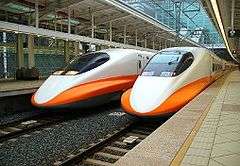Hayate (train)
|
E5 series set U6 on a Hayate service, November 2011 | |
| Overview | |
|---|---|
| Service type | Shinkansen |
| Locale | Honshu, Japan |
| First service | 1 December 2002 |
| Current operator(s) | JR East |
| Route | |
| Start | Tokyo |
| End | Shin-Aomori |
| Distance travelled | 674.9 km (419.4 mi) |
| Service frequency | Hourly |
| Line used | Tohoku Shinkansen |
| On-board services | |
| Class(es) | Standard + Green + Gran Class |
| Catering facilities | Trolley service |
| Technical | |
| Rolling stock | E2 series, E5 series |
| Track gauge | 1,435 mm (4 ft 8 1⁄2 in) |
| Electrification | 25 kV AC overhead |
| Operating speed | 275 km/h (170 mph) |
Hayate (はやて) is a high-speed Shinkansen service operated on the Tohoku Shinkansen in Japan by East Japan Railway Company (JR East) since 2002. It operates as far as the northern terminus of Shin-Aomori, and it is the second-fastest service on the Tohoku Shinkansen, operating at a top speed of 275 km/h (170 mph) between Utsunomiya and Morioka. These services were inaugurated with the opening of the Tohoku Shinkansen extension to Hachinohe on 1 December 2002.[1]
The name "Hayate" has not been used previously on any train service in Japan. The name was chosen with input from the public; roughly translated, it means a strong or violent wind; however, it carries positive connotations of speed and power.
Service pattern
From its introduction in 2002, the Hayate service used 10-car E2 Series Shinkansen units. With the opening of the Tohoku Shinkansen extension to the new northern terminus of Shin-Aomori from 4 December 2010, 15 return trips a day operating between Tokyo and Shin-Aomori, with one return trip between Sendai and Shin-Aomori and one return trip between Morioka and Shin-Aomori. The fastest service from Tokyo to Shin-Aomori is 3 hours 20 minutes.[2]
From 19 November 2011, E5 series trainsets were also introduced on some Hayate services. These services are limited to the current maximum speed of 275 km/h.[3]
Hayate services are coupled with Komachi services as far as Morioka, where the Komachi cars are uncoupled and proceed to Akita Station via the Akita Shinkansen. Due to the popularity of the fast train service from Tokyo to the Tōhoku region, seat reservations are compulsory on both the Hayate and Komachi.
Stations
Hayate services stop at the following stations.
- Tokyo
- Ueno*
- Ōmiya
- Sendai
- Furukawa*
- Kurikoma-Kōgen*
- Ichinoseki*
- Mizusawa-Esashi*
- Kitakami*
- Shin-Hanamaki*
- Morioka
- Iwate-Numakunai*
- Ninohe*
- Hachinohe*
- Shichinohe-Towada*
- Shin-Aomori
(*) These stations are not served by all trains.
Train formations

Hayate services are operated by 10-car E2 series or E5 series trainsets, with car 1 at the Tokyo end. All seats are reserved and no-smoking.[4]
E2 series Hayate
| Car No. | 1 | 2 | 3 | 4 | 5 | 6 | 7 | 8 | 9 | 10 |
|---|---|---|---|---|---|---|---|---|---|---|
| Class | Standard | Standard | Standard | Standard | Standard | Standard | Standard | Standard | Green | Standard |
| Facilities | Cardphone | Cardphone | Wheelchair space | Wheelchair space |
E5 series Hayate
| Car No. | 1 | 2 | 3 | 4 | 5 | 6 | 7 | 8 | 9 | 10 |
|---|---|---|---|---|---|---|---|---|---|---|
| Class | Standard | Standard | Standard | Standard | Standard | Standard | Standard | Standard | Green | Gran Class |
| Facilities | Cardphone | Cardphone/ Wheelchair space | Wheelchair space |
Future developments
From 26 March 2016, with the opening of the Hokkaido Shinkansen from Shin-Aomori to Shin-Hakodate-Hokuto, the Hayate name will be used for services operating between Morioka, Shin-Aomori, and Shin-Hakodate-Hokuto.[5] From the start of the 26 March 2016 timetable revision, one return service will operate daily between Morioka and Shin-Hakodate-Hokuto, and one return service daily will operate between Shin-Aomori and Shin-Hakodate-Hokuto. These services will be formed of 10-car E5 or H5 series trainsets.[6]
See also
References
- ↑ JR新幹線&特急列車ファイル [JR Shinkansen & Limited Express Train File]. Japan: Kōtsū Shimbun. 2008. p. 16. ISBN 978-4-330-00608-6.
- ↑ 東北新幹線 新青森開業における運転時刻について [Details of timetable following opening of Shin-Aomori Station] (pdf) (in Japanese). East Japan Railway Company. 7 September 2010. Retrieved 4 December 2010.
- ↑ 東北新幹線「はやぶさ」に投入しているE5系車両を「はやて」「やまびこ」に導入! [Tohoku Shinkansen "Hayabusa" E5 series trains to be introduced on "Hayate" and "Yamabiko" services] (pdf). Press release (in Japanese). Japan: East Japan Railway Company. 12 September 2011. Retrieved 12 September 2011.
- ↑ JR Timetable, August 2011 issue. p.999
- ↑ 北海道新幹線の列車名決定について [Details of Hokkaido Shinkansen train names] (PDF). News release (in Japanese). Japan: Hokkaido Railway Company. 20 November 2014. Retrieved 20 November 2014.
- ↑ 北海道新幹線 新青森~新函館北斗間開業に伴う運行計画の概要について [Details of operations following opening of Hokkaido Shinkansen between Sendai and Shin-Hakodate-Hokuto] (PDF). News release (in Japanese). Japan: East Japan Railway Company. 16 September 2015. Retrieved 16 September 2015.
External links
- JR East E2 series Hayate (Japanese)
- JR East E5 series Hayabusa/Hayate (Japanese)
| |||||||||||||||||||||||||||||||||||||||||||||||||||||||||||||||||||||||||||||
| ||||||||||||||||||||||||||||||||





.svg.png)